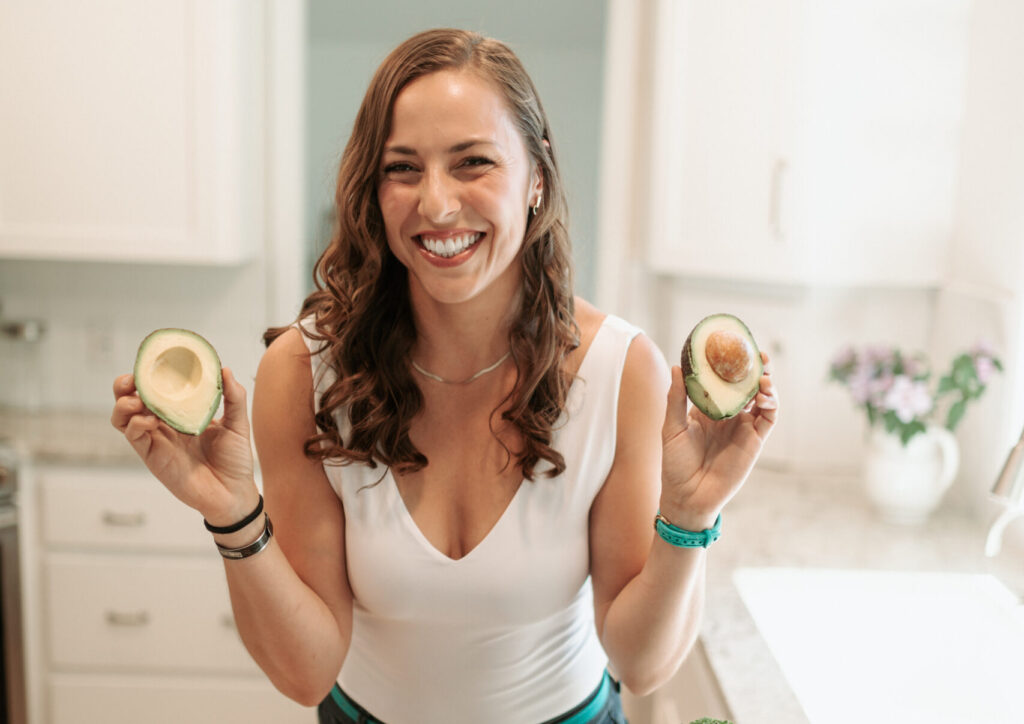
Macronutrients: protein, fats & carbohydrates are the main large category of nutrients that make up your diet.
But, I thought the concept was calories in vs calories out – why macros?
Calories in vs calories out can help you lose WEIGHT.
Macros help you retain/build muscle and can be manipulated to do so while losing fat.
PROTEIN
1g = 4 CALORIES 20-35% TOTAL INTAKE
Proteins are made up of chains of amino acids. They are the main structural components of the muscle as well as the brain, nervous system, blood, skin, and hair. They transport vitamins and minerals throughout the body, help balance bodily fluids, and in a caloric deficit can be used as energy.
Your protein requirement is dependent on what kinds of activity you’re doing, what your goals are, your age, and lean body mass (LBM) – but as a general rule protein is the most important for any goal that involves building or retaining muscle. If you’re not getting the adequate protein your body will reach for the first available source of protein which is muscle tissue.
AS A MINIMUM TO BUILD/MAINTAIN MUSCLE WE NEED 1 G/LB OF LEAN BODY MASS
0-40 YRS OLD 40-60 YRS OLD 60+ YRS OLD
CALORIC DEFICIT .8-1 G/LB LBM 1-1.3 G/LB LBM 1.3-1.5 G/LB LBM
NO DEFICIT 1-1.3 G/LB LBM 1.3-1.6 G/LB LBM 1.6-1.7 G/LB LBM
As we age our protein requirements increase due to the increased rate of muscle degeneration. The above chart is a very specific way to calculate your needs but can only be used if you have had your body composition tested and know your lean body mass.
If you don’t have any idea – you can use the percentage requirements as a guide (table below). If you’re in a deficit or older, aim toward the higher end of the percentage. If you’re not in a deficit and younger, stay toward the lower end. Again, our goal is minimum effective dosage because we want to leave enough calories to be getting adequate fuel from carbohydrates and fats as well.
GOAL / CALORIC STATE % OF PROTEIN (OF TOTAL CALS)
FAT LOSS / CALORIC DEFICIT 25-35%
MAINTENANCE 20-25%
SURPLUS / MUSCLE BUILDING 20-30% (PERSONAL PREFERENCE)
EXAMPLE COMPUTATION
AGE: 30 years old
GOAL: Fat Loss
DEFICIT CALORIES: 1607
BODY WEIGHT: 175
BODY FAT %: 28
USING PERCENTAGE ESTIMATE: 30% PROTEIN
G/PROTEIN = TOTAL CALS X % / 4 G/CAL
1607 X 30% = 482 CALS PROTEIN / 4 G/CAL = 120G PROTEIN
USING LBM CHART MULTIPLIER
175LBS X 28% BF = 49 LBS BF
175LBS – 49LBS BF =126 LBS LBM
126 LBS LBM X 1 – 1.2 G/ LB LBM =
RANGE OF 126 – 151 G PROTEIN
As you can see, both methods came out with similar results.
SEE PROTEIN SOURCE TABLE IN APPENDIX A
FATS

1g = 9 CALORIES
20-40% TOTAL INTAKE
Fats provide energy and aid in nutrient absorption. There are good fats that contribute to a healthy diet, and there are bad ones that can cause issues in your body. To maintain organ/hormone function your body needs a minimum 20% of your daily caloric intake to come from fats.
CHOLESTEROL: Fat-like waxy substance produced in the liver and found in the cell membrane of all animal tissues to provide cell structure and integrity. It’s also found in the adrenal glands, testes/ovaries, and liver where it forms hormones and bile acids. Cholesterol is carried through the bloodstream by water-soluble protein carriers called lipoproteins classified mainly as HIGH-DENSITY LIPOPROTEINS (HDL) and LOW-DENSITY LIPOPROTEINS (LDL). HDL’s remove excess cholesterol from the arteries and LDL’s will attach themselves to your artery walls causing blockages.
SATURATED FATS: Naturally occurring fats that are typically solid at room temperature. These mainly come from animal and dairy products, but also palm & coconut oil. While grass-fed, organic products can provide many health benefits, you want to minimize the number of saturated fats you intake to less than 10% of total calories.
POLYUNSATURATED FATS: These are the healthiest fats to intake and should comprise 3-10% of your total daily intake. These include Omega 3’s (alpha linoleic acid) found in pastured egg yolks, and cold water fish like tuna, salmon, mackerel, crab, and shrimp. They are known to reduce inflammation, cholesterol, and triglyceride levels. Omega 6’s (linoleic acid) is found in flaxseeds, canola, and soybean oils as well as leafy vegetables. These are usually over-consumed due to processed foods.
MONOUNSATURATED FATS: Primarily found in plant sources and typically liquid at room temperature. Examples include oil, nuts, seeds, and avocados. They are recommended to make up 15-20% of your caloric intake.
TRANS AND HYDROGENATED FATS: These are synthetic fats that have been broken down to create a longer shelf life in most processed foods. These fats are the worst kind for you as they greatly increase your low-density lipoproteins clogging arteries and should be avoided at all costs. These are found in most processed chips, cookies, cakes, and margarine.
I like to calculate fats second because hormonal health comes next in the line of priorities. As always, your intake will vary, however a MINIMUM for proper hormone function is around 20% of your overall intake, so I don’t ever suggest going under that. If you’re in a deficit going for fat loss, I like fat intake to be on the lower end because it leaves room for carbohydrates as fast fuel for workouts. Usually, I will set them around 25% for someone in a deficit, the more calories you have to play with – I may increase that to 30-35% depending on client preference and general eating habits to help with adherence.
This is where a lot of flexibility can come into play. Technically, in terms of fat loss, your ratio of fats to carbs isn’t a huge determining factor – the reason it matters is that carbohydrates are going to be your muscle’s main fuel source. If you are highly active, lifting weights, and want to maintain muscle mass, you should prioritize more carbohydrates. However, the biggest determining factor of ANY diet is adherence. If you find you are consistently over your targets in fats, then setting them a little higher and decreasing carbs is an okay adjustment.
CALCULATION- (Using above deficit calories)
FAT INTAKE = (TOTAL CALORIES X 25%) / 9 CALS/G
1607 CALS X .25 = 401 CALS
401 CALS / 9 CALS/G = 44G FAT/ DAY
SEE FAT SOURCES TABLE IN APPENDIX A
CARBOHYDRATES
1g=4 CALORIES
30-65% TOTAL INTAKE
Carbohydrates are the body’s main and preferred energy source. They serve as fuel for many metabolic functions including the brain, anaerobic and aerobic exercise, and are required to efficiently break down fat.
FIBER: A type of carbohydrate that helps improve digestive health and cholesterol levels as well as regulates the speed at which a carbohydrate is digested.
SIMPLE CARBOHYDRATES: Quickly digested causing blood sugar spike without other nutrients for use in the body. Monosaccharides – (glucose, fructose (fruit), galactose) Disaccharides – (lactose (milk), sucrose (table sugar) and maltose
COMPLEX CARBOHYDRATES: Slowly digested allowing for balance in blood sugar while providing fiber and vitamins. Oligosaccharides (Mostly indigestible plant/fruit fibers-sweeteners) Polysaccharides (Starch, Fiber, Glycogen)
CALCULATION
TOTAL CARBS (G) = (TOTAL CALORIES – PROTEIN CALORIES – FAT CALORIES) / 4 CALS/G
1607 CALS – 482 CALS PROTEIN – 401 CALS FAT = 724 CALS CARBS
724 CALS CARBS / 4 CALS/G = 181 G CARBS
SEE CARBOHYDRATE SOURCES TABLE IN APPENDIX A
FULL MACRO CALCULATION– (Recap)
PROTEIN
USING PERCENTAGE ESTIMATE: 30%
PROTEIN INTAKE (G) = (TOTAL CALS X 25-40%) / 4 G/CAL
USING LEAN BODY MASS MULTIPLIER
PROTEIN INTAKE(G) = LBM X CHART MULTIPLIER
FAT
FAT INTAKE (G) = (TOTAL CALORIES X 20-35%) / 9 CALS/G
CARBOHYDRATES
CARB INTAKE (G) = (TOTAL CALORIES – PROTEIN CALORIES – FAT CALORIES) / 4 CALS/G
REVERSE DIET

Our bodies are insanely efficient. When you’re in a caloric deficit, regardless of how conservative you are with it – your metabolism will adapt and slow down. This is our physiology, which is great when we actually have a shortage of food. It means we can SURVIVE on less – but we’re not THRIVING. It’s not optimal, and it’s not ideal. This is why you cannot stay on low calories forever, and potentially why if you did your calculations on the macros calculator and found that it was far higher than what you normally eat – you may need to reverse your diet BEFORE trying to lose weight.
There are a couple of things we can do to combat this and reverse dieting is one of them. This is generally used after a diet phase or if you have been way below your recommended maintenance calories based on the above equations for an extended period of time. The goal of this phase is to up-regulate your metabolism with increased calories to improve organ function and hormone health.
What this looks like is slowly increasing your calories by 5-15% over a few weeks or months until you reach a point where maybe you gained a few lbs, but then you hit a plateau. You might stay here for a few weeks and then see if you can increase it a little more. I recommend immediately going back up to your maintenance post-cut (which will not be your maintenance from when you started the cut, because your metabolism has slowed), setting your protein, then increasing with a 70/30 ratio of carbs to fats (or 60/40 depending on your preference/adherence).
The amount of time that you stay here depends on your goals and your past diet history. If you’ve been dieting or at a low-calorie intake for 6+ months without any kind of maintenance phase, you may need to spend 6+ months working your metabolism back up to optimum function. If you’ve been chronic or yo-yo dieting for years, it could take a year + or out of a deficit to fully heal and optimize your metabolism again.
You should also expect to gain some fat here – this is normal. Especially if you have dropped too low body fat, you will need to gain some back in order to restore hormonal balance. If you are overweight and simply need to boost your metabolism – if you are including a proper training regimen in this, chances are you will actually see a decrease in body fat and an increase in muscle.
Everyone is different and there are a ton of variables so responses to this will vary from person to person.
STEP 1: FIND YOUR TRUE MAINTENANCE.
When coming out of a caloric deficit, you should immediately go back up to maintenance and a solid protein intake and a minimum 20% fats. This is best found by method 3 in the above “finding your starting calories” but you can start with some general calculations. Spend a week here to ensure you’re actually at maintenance then go from there. If you gain more than 1-2 lbs from this – back down 100-150 calories and try again. If you’re still dropping weight, increase by 50-150 cals.
STEP 2: WEEKLY INCREASE
Each week or every couple of weeks you should aim to increase calories by 50-150 or 5-15% in carbs and fats depending on your goals. The slower you increase the less fat you will gain, but the longer the transition will take – patience and consistency are key. Often the first week of an increase you’ll see a spike in weight generally due to increase carbs, but by the second week, it will level out.
STEP 3: FINDING A STOPPING POINT
I suggest using the macro calculator as your guide to metabolic health. When you’ve reached at least 100-200 calories of your maintenance calculation as a consistent intake that you can maintain weight on, you’re doing pretty well. I will always suggest you try to reach it or even surpass it because our bodies are capable of more than we give them credit for, and the more nutrients you can give it, the better, but reaching it will put you at a healthy and sustainable intake. If your main goal is to build muscle, you will need to go above maintenance calories. How much will be dependent on your comfort level with fat gain and how much muscle you want to build.
STEP 4: STAY AT MAINTENANCE OR GO INTO A CUT
If you are reversing out of a diet period that you have reached your goals in, then you would simply stop at maintenance. If you are reversing out of a caloric deficit but have not yet met your compositional goals then you can safely and healthily go into a cut again. You will find that once you have reversed up into higher calories, you shouldn’t need to go so low for the next round of dieting. In other words, you can lose weight on higher calories. Yay!
EXAMPLE:
170LB FEMALE / 35 YRS OLD / 5’5″
DEFICIT CALORIES: 1460 – LOSING 1LB/WEEK
CURRENT MAINTENANCE: 1675
GOAL MAINTENANCE: 2019
REVERSE WEEK 1:
CALS – 1675
PROTEIN – 136G
CARB – 199G
FAT – 37G
REVERSE WEEK 2 & 3:
CALS – 1850
PROTEIN – 136G
CARB – 234G
FAT – 41G
REVERSE WEEK 4:
CALS – 1950
PROTEIN – 136G
CARB – 239G
FAT – 49G
REVERSE WEEK 5:
CALS – 2019
PROTEIN – 136G
CARB – 242G
FAT – 56G
REVERSE WEEK 6:
CALS – 2100
PROTEIN – 136G
CARB – 247G
FAT – 63G
REVERSE DIET AND TRAINING
Like the diet itself, what you do with your training depends on where you’re at and what you’ve been doing. If you’re coming out of a bodybuilding competition, you may have been doing a lot of cardio and some pretty high-intensity training so you may need to start winding that back. If you are coming into this with inconsistent training and yo-yo dieting – you may need to ramp it up a little bit.
SCALING BACK
If you’re needing to back down off training, like reversing – do it slowly. Each week take away 30 mins or so of cardio. Start to focus more on strength lifts and overall lifting volume to build back strength and muscle.
STEPPING UP
If you’re in the camp of needing to ramp things up a little bit – this is a great way to encourage your body to start putting those extra calories to use! Create a consistent program of at least 3 days/ week of strength training focusing on compound lifts. Shameless plug – my VIGOR -TRAINING GUIDE would be a great place to start. You could also start to add in cardio 10-20 mins at a time a couple of days a week up to the recommended amount: at least 150 minutes of moderate aerobic activity or 75 minutes of vigorous aerobic activity a week, or a combination of moderate and vigorous activity.
As you can see, reversing dieting is highly individual. It requires consistency and while it’s not as instantaneously rewarding as losing weight you have to keep in mind that this is for the purpose of LONGEVITY AND OVERALL HEALTH. When you successfully complete a full reverse I can promise you higher energy levels, less hunger, more strength, and better hormonal balance!

Women’s Functional Nutritionist & Fitness Specialist along with CEO of Elysian Women’s Wellness.
God, family, fitness – in that order. Fitness isn’t my job, it’s my passion. My favorite things include traveling the world, being a mama and making a difference.
14 years of experience in the wellness industry has brought me to an understanding that when you’re ready – you’ll do it. So when you are, we’re here to keep you simply well.
The last “program” you’ll ever buy. Your individualized training & nutrition plan that teaches the why & how to create lasting changes with me by your side every step of the way!

Error: No feed found.
Please go to the Instagram Feed settings page to create a feed.
Level 0, 1, 2 & 3: Level Up your workouts with beginner to advanced plans designed with a focus lift each month, progressive overload, instructional videos & all inclusive training & nutrition guides.
Copyright ©2025. Gamechanger
A BRANDT CREATIVE CO. TEMPLATE. Trusted by Wimgo.